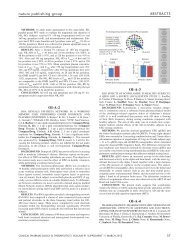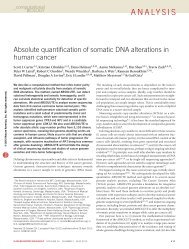open access: Nature Reviews: Key Advances in Medicine
open access: Nature Reviews: Key Advances in Medicine
open access: Nature Reviews: Key Advances in Medicine
Create successful ePaper yourself
Turn your PDF publications into a flip-book with our unique Google optimized e-Paper software.
RHEUMATOLOGY<br />
fibrosis and ameliorated established fibrosis.<br />
9 Consistent with these f<strong>in</strong>d<strong>in</strong>gs, mice<br />
deficient <strong>in</strong> tryptophan hydroxylase 1—the<br />
rate-limit<strong>in</strong>g enzyme for 5-HT production<br />
outside the central nervous system—had<br />
reduced experimental sk<strong>in</strong> fibrosis. 9 These<br />
f<strong>in</strong>d<strong>in</strong>gs, together with recent results from<br />
5-HT receptor antagonists <strong>in</strong> experi mental<br />
pulmonary or liver fibrosis, suggest that<br />
5-HT–5-HT 2B receptor signal<strong>in</strong>g l<strong>in</strong>ks<br />
vascular damage and platelet activation to<br />
tissue remodel<strong>in</strong>g, and highlight the 5-HT 2B<br />
receptor as a novel therapeutic target to treat<br />
fibrotic diseases.<br />
In summary, block<strong>in</strong>g extr<strong>in</strong>sic coagulation<br />
system and/or platelet activation might<br />
represent promis<strong>in</strong>g future strategies for SSc<br />
treatment. From mechanisms to new medic<strong>in</strong>es,<br />
research <strong>in</strong> 2011 has made tenta tive<br />
steps to provid<strong>in</strong>g an effective targeted<br />
therapy for SSc. Although the efficacy of<br />
imat<strong>in</strong>ib has not yet been confirmed,<br />
mecha nistic <strong>in</strong>sights <strong>in</strong>to the development<br />
of fibrosis <strong>in</strong> SSc have provided vital<br />
clues for the development of new drugs for<br />
this challeng<strong>in</strong>g disease and trials of new<br />
therapies are ongo<strong>in</strong>g.<br />
Université Paris Descartes, Faculté de<br />
Médec<strong>in</strong>e, Service de Médec<strong>in</strong>e Interne,<br />
Hôpital Coch<strong>in</strong>, 27 rue du Faubourg Sa<strong>in</strong>t<br />
Jacques, 75014 Paris, France.<br />
luc.mouthon@cch.aphp.fr<br />
Compet<strong>in</strong>g <strong>in</strong>terests<br />
The author declares associations with the follow<strong>in</strong>g<br />
companies: Actelion, GlaxoSmithKl<strong>in</strong>e, Lilly, Pfizer.<br />
See the article onl<strong>in</strong>e for full details of the<br />
relationships.<br />
1. Bhattacharyya, S., Wei, J. & Varga, J.<br />
Understand<strong>in</strong>g fibrosis <strong>in</strong> systemic sclerosis:<br />
shift<strong>in</strong>g paradigms, emerg<strong>in</strong>g opportunities.<br />
Nat. Rev. Rheumatol. http://dx.doi.org/<br />
10.1038/nrrheum.2011.149.<br />
2. Distler, J. H. & Distler, O. Imat<strong>in</strong>ib as a novel<br />
therapeutic approach for fibrotic disorders.<br />
Rheumatology (Oxford) 48, 2–4 (2009).<br />
3. Aono, Y. et al. Imat<strong>in</strong>ib as a novel antifibrotic<br />
agent <strong>in</strong> bleomyc<strong>in</strong>-<strong>in</strong>duced pulmonary fibrosis<br />
<strong>in</strong> mice. Am. J. Respir. Crit. Care Med. 171,<br />
1279–1285 (2005).<br />
4. Distler, J. H. et al. Imat<strong>in</strong>ib mesylate reduces<br />
production of extracellular matrix and<br />
prevents development of experimental dermal<br />
fibrosis. Arthritis Rheum. 56, 311–322<br />
(2007).<br />
5. Spiera, R. F. et al. Imat<strong>in</strong>ib mesylate<br />
(Gleevec) <strong>in</strong> the treatment of diffuse<br />
cutaneous systemic sclerosis: results of a<br />
1-year, phase IIa, s<strong>in</strong>gle-arm, <strong>open</strong>-label<br />
cl<strong>in</strong>ical trial. Ann. Rheum. Dis. 70, 1003–1009<br />
(2011).<br />
6. Khanna, D. et al. A one-year, phase I/IIa,<br />
<strong>open</strong>-label pilot trial of imat<strong>in</strong>ib mesylate <strong>in</strong> the<br />
treatment of systemic sclerosis-associated<br />
active <strong>in</strong>terstitial lung disease. Arthritis Rheum.<br />
63, 3540–3546 (2011).<br />
7. Pope, J. et al. Imat<strong>in</strong>ib <strong>in</strong> active diffuse<br />
cutaneous systemic sclerosis: results of a<br />
six-month, randomized, double-bl<strong>in</strong>d, placebocontrolled,<br />
proof-of-concept pilot study at a<br />
s<strong>in</strong>gle center. Arthritis Rheum. 63, 3547–3551<br />
(2011).<br />
8. Chrysanthopoulou, A. et al. Tissue factorthromb<strong>in</strong><br />
signal<strong>in</strong>g enhances the fibrotic<br />
activity of myofibroblasts <strong>in</strong> systemic sclerosis<br />
through up-regulation of endothel<strong>in</strong> receptor A.<br />
Arthritis Rheum. 63, 3586–3597 (2011).<br />
9. Dees, C. et al. Platelet-derived seroton<strong>in</strong> l<strong>in</strong>ks<br />
vascular disease and tissue fibrosis. J. Exp.<br />
Med. 208, 961–972 (2011).<br />
10. Postlethwaite, A. E. & Chiang, T. M. Platelet<br />
contributions to the pathogenesis of systemic<br />
sclerosis. Curr. Op<strong>in</strong>. Rheumatol. 19, 574–579<br />
(2007).<br />
VASCULITIS IN 2011<br />
The renaissance of granulomatous<br />
<strong>in</strong>flammation <strong>in</strong> AAV<br />
Stephan D. Gadola and Wolfgang L. Gross<br />
In 2011, the year that subtypes of ANCA-associated vasculitis (AAV) were<br />
officially renamed accord<strong>in</strong>g to key pathological characteristics, important<br />
progress was made not only <strong>in</strong> differentiat<strong>in</strong>g these subtypes, but also <strong>in</strong><br />
understand<strong>in</strong>g—and treat<strong>in</strong>g—their eponymous manifestations.<br />
Gadola, S. D. & Gross, W. L. Nat. Rev. Rheumatol. 8, 74–76 (2012); published onl<strong>in</strong>e 10 January 2012;<br />
corrected onl<strong>in</strong>e 24 January 2012; doi:10.1038/nrrheum.2011.218<br />
Granulomatosis with polyangiitis (GPA, formerly<br />
Wegener´s granulomatosis), Churg-<br />
Strauss syndrome (CSS) and microscopic<br />
polyangiitis (MPA) constitute the ant<strong>in</strong>eutrophil<br />
cytoplasmic antibody (ANCA)associated<br />
vasculitides (AAV), forms of<br />
primary small-vessel vasculitis associated<br />
with ANCA seropositivity. Ow<strong>in</strong>g to the<br />
rarity of their disease, patients with dif ferent<br />
AAV are often pooled <strong>in</strong> cl<strong>in</strong>ical trials. Disease<br />
evolution, organ <strong>in</strong>volvement, prognosis,<br />
and other parameters , however, dif fer<br />
substantially between GPA, CSS and MPA,<br />
although the mechanistic bases for these<br />
differences rema<strong>in</strong> largely unexplored. To<br />
unravel them, effective classification of<br />
patients with AAV is essential, beg<strong>in</strong>n<strong>in</strong>g<br />
with def<strong>in</strong><strong>in</strong>g—and nam<strong>in</strong>g—the subtypes.<br />
2011 saw the launch of an <strong>in</strong>ternational<br />
effort among vasculitis experts, <strong>in</strong>clud<strong>in</strong>g<br />
rheumatologists, nephrologists, pathologists<br />
and others, to replace honorific eponyms of<br />
<strong>Key</strong> advances<br />
■ A new artificial neural network helps<br />
to differentiate subtypes of ANCAassociated<br />
vasculitis, <strong>in</strong>clud<strong>in</strong>g<br />
granulomatosis with polyangiitis (GPA) 2<br />
■ The effects of rituximab on granulomatous<br />
and vasculitic manifestations of GPA<br />
offer hope for patients with refractory<br />
disease, plus <strong>in</strong>sights <strong>in</strong>to the pathology<br />
of granulomatous lesions 7<br />
■ Autoantibodies with transmembrane<br />
prote<strong>in</strong> targets are found—and<br />
generated—<strong>in</strong> GPA granulomas, but are<br />
undetectable <strong>in</strong> plasma 9<br />
diseases with names that highlight diseasespecific<br />
characteristics. 1 GPA is <strong>in</strong> fact the test<br />
case for this <strong>in</strong>itiative; its new name underl<strong>in</strong>es<br />
the cl<strong>in</strong>ical and pathological similarities<br />
between GPA and MPA with regard to smallcaliber<br />
vessel <strong>in</strong>volvement, while emphasiz<strong>in</strong>g<br />
the importance of granulomatous<br />
<strong>in</strong>flammation as a dist<strong>in</strong>ctive feature of GPA<br />
(Figure 1a). Indeed, s<strong>in</strong>ce the <strong>in</strong>troduction<br />
of effective immunosuppressive protocols<br />
that control vasculitic manifestations of GPA<br />
(and other AAV), cl<strong>in</strong>icians have <strong>in</strong>creas<strong>in</strong>gly<br />
faced the challenges posed by granulomatous<br />
manifestations (for which effective treatments<br />
have lagged beh<strong>in</strong>d). Differentiat<strong>in</strong>g<br />
GPA and MPA, however, is sometimes difficult<br />
(biopsy proof of GPA is required, and<br />
established diagnostic criteria are lack<strong>in</strong>g),<br />
especially when <strong>in</strong>ter discipl<strong>in</strong>ary care cannot<br />
be provided. Surrogate markers of granulomatous<br />
<strong>in</strong>flammation have been proposed to<br />
dis t<strong>in</strong>guish GPA, but are, as yet, unvalidated.<br />
L<strong>in</strong>der and colleagues 2 stepped <strong>in</strong>to this<br />
breach <strong>in</strong> 2011, apply<strong>in</strong>g an artificial neural<br />
net work (ANN) approach to generate and<br />
validate improved criteria for dist<strong>in</strong>guish<strong>in</strong>g<br />
GPA and MPA. The ability of ANNs to f<strong>in</strong>d<br />
patterns <strong>in</strong> complex data sets has previously<br />
been used to differen tiate GPA and CSS. 3<br />
In tra<strong>in</strong><strong>in</strong>g the ANN, L<strong>in</strong>der et al. 2 identified<br />
four potentially rele vant parameters<br />
—<strong>in</strong>volvement of the nose, s<strong>in</strong>uses, or ears,<br />
and presence of pulmonary nodules—to help<br />
<strong>in</strong> differen tiat<strong>in</strong>g between GPA and MPA.<br />
Indeed, when these cri teria were applied as<br />
the only <strong>in</strong>put neurons, the ANN correctly<br />
differentiated cases of GPA and MPA with an<br />
S74 | JANUARY 2012 www.nature.com/reviews








